A Critical Numeracy Approach to a Contemporary Issue Report
VerifiedAdded on 2023/02/01
|20
|5030
|72
Report
AI Summary
This report provides a comprehensive analysis of a critical numeracy approach to contemporary issues, specifically focusing on the measles epidemic and vaccination efforts. It explores the use of mathematical concepts in understanding and addressing real-world problems, emphasizing the importance of critical thinking and decision-making. The report outlines the process of mathematising the issue, including problem definition, information gathering, model building, and solution evaluation. It also details a student activity that utilizes the four-resource numeracy model to examine measles vaccination rates and the impact of percentages. The report considers student background knowledge, required resources, and adaptations for ESL students, highlighting the relevance of critical numeracy within and outside the curriculum. The methodology involves using the four resource model which includes decoding, meaning making, using, and analyzing to give in-depth insights into the mathematical ideas and contexts.
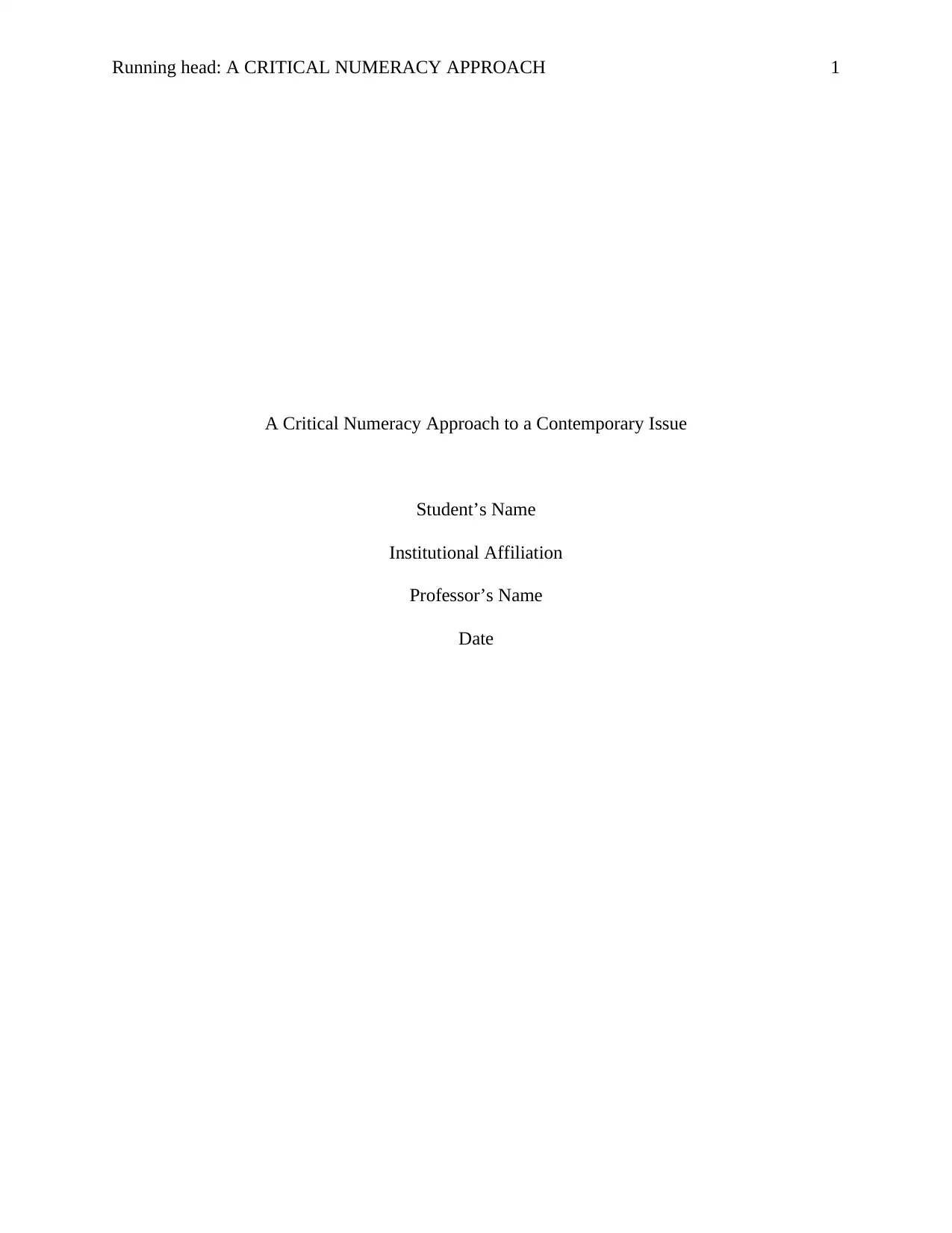
Running head: A CRITICAL NUMERACY APPROACH 1
A Critical Numeracy Approach to a Contemporary Issue
Student’s Name
Institutional Affiliation
Professor’s Name
Date
A Critical Numeracy Approach to a Contemporary Issue
Student’s Name
Institutional Affiliation
Professor’s Name
Date
Paraphrase This Document
Need a fresh take? Get an instant paraphrase of this document with our AI Paraphraser
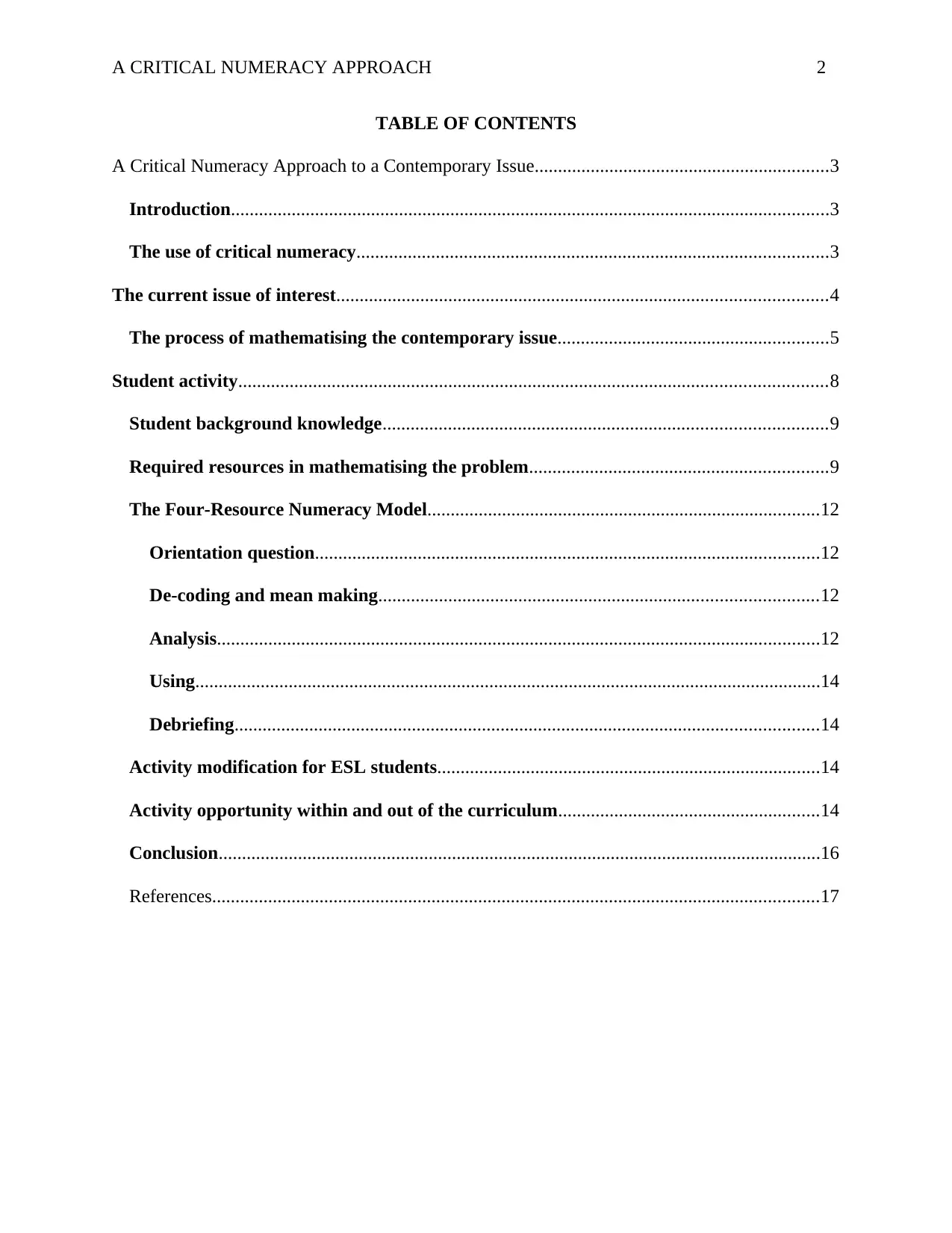
A CRITICAL NUMERACY APPROACH 2
TABLE OF CONTENTS
A Critical Numeracy Approach to a Contemporary Issue...............................................................3
Introduction................................................................................................................................3
The use of critical numeracy.....................................................................................................3
The current issue of interest.........................................................................................................4
The process of mathematising the contemporary issue..........................................................5
Student activity..............................................................................................................................8
Student background knowledge...............................................................................................9
Required resources in mathematising the problem................................................................9
The Four-Resource Numeracy Model....................................................................................12
Orientation question............................................................................................................12
De-coding and mean making..............................................................................................12
Analysis.................................................................................................................................12
Using......................................................................................................................................14
Debriefing.............................................................................................................................14
Activity modification for ESL students..................................................................................14
Activity opportunity within and out of the curriculum........................................................14
Conclusion.................................................................................................................................16
References..................................................................................................................................17
TABLE OF CONTENTS
A Critical Numeracy Approach to a Contemporary Issue...............................................................3
Introduction................................................................................................................................3
The use of critical numeracy.....................................................................................................3
The current issue of interest.........................................................................................................4
The process of mathematising the contemporary issue..........................................................5
Student activity..............................................................................................................................8
Student background knowledge...............................................................................................9
Required resources in mathematising the problem................................................................9
The Four-Resource Numeracy Model....................................................................................12
Orientation question............................................................................................................12
De-coding and mean making..............................................................................................12
Analysis.................................................................................................................................12
Using......................................................................................................................................14
Debriefing.............................................................................................................................14
Activity modification for ESL students..................................................................................14
Activity opportunity within and out of the curriculum........................................................14
Conclusion.................................................................................................................................16
References..................................................................................................................................17
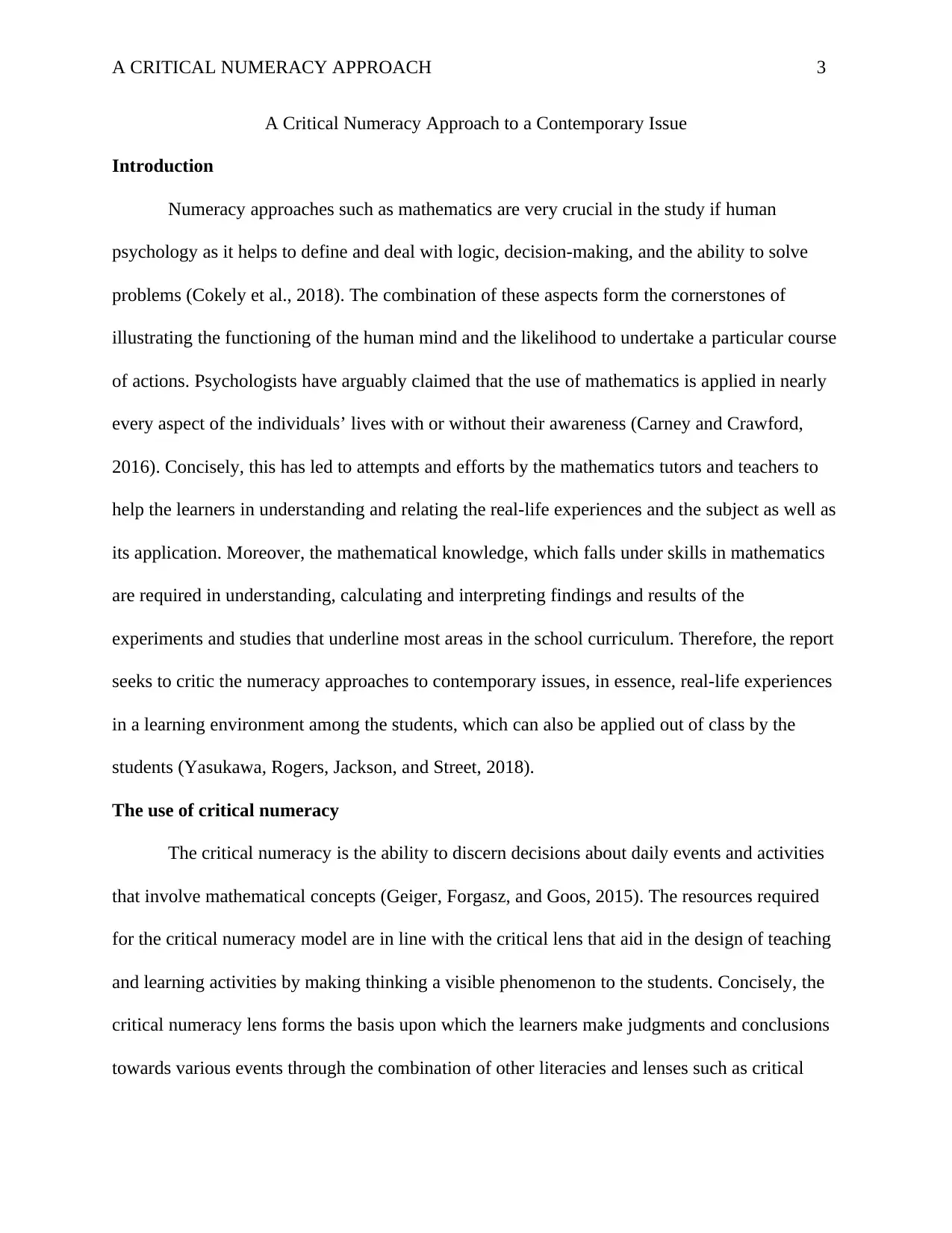
A CRITICAL NUMERACY APPROACH 3
A Critical Numeracy Approach to a Contemporary Issue
Introduction
Numeracy approaches such as mathematics are very crucial in the study if human
psychology as it helps to define and deal with logic, decision-making, and the ability to solve
problems (Cokely et al., 2018). The combination of these aspects form the cornerstones of
illustrating the functioning of the human mind and the likelihood to undertake a particular course
of actions. Psychologists have arguably claimed that the use of mathematics is applied in nearly
every aspect of the individuals’ lives with or without their awareness (Carney and Crawford,
2016). Concisely, this has led to attempts and efforts by the mathematics tutors and teachers to
help the learners in understanding and relating the real-life experiences and the subject as well as
its application. Moreover, the mathematical knowledge, which falls under skills in mathematics
are required in understanding, calculating and interpreting findings and results of the
experiments and studies that underline most areas in the school curriculum. Therefore, the report
seeks to critic the numeracy approaches to contemporary issues, in essence, real-life experiences
in a learning environment among the students, which can also be applied out of class by the
students (Yasukawa, Rogers, Jackson, and Street, 2018).
The use of critical numeracy
The critical numeracy is the ability to discern decisions about daily events and activities
that involve mathematical concepts (Geiger, Forgasz, and Goos, 2015). The resources required
for the critical numeracy model are in line with the critical lens that aid in the design of teaching
and learning activities by making thinking a visible phenomenon to the students. Concisely, the
critical numeracy lens forms the basis upon which the learners make judgments and conclusions
towards various events through the combination of other literacies and lenses such as critical
A Critical Numeracy Approach to a Contemporary Issue
Introduction
Numeracy approaches such as mathematics are very crucial in the study if human
psychology as it helps to define and deal with logic, decision-making, and the ability to solve
problems (Cokely et al., 2018). The combination of these aspects form the cornerstones of
illustrating the functioning of the human mind and the likelihood to undertake a particular course
of actions. Psychologists have arguably claimed that the use of mathematics is applied in nearly
every aspect of the individuals’ lives with or without their awareness (Carney and Crawford,
2016). Concisely, this has led to attempts and efforts by the mathematics tutors and teachers to
help the learners in understanding and relating the real-life experiences and the subject as well as
its application. Moreover, the mathematical knowledge, which falls under skills in mathematics
are required in understanding, calculating and interpreting findings and results of the
experiments and studies that underline most areas in the school curriculum. Therefore, the report
seeks to critic the numeracy approaches to contemporary issues, in essence, real-life experiences
in a learning environment among the students, which can also be applied out of class by the
students (Yasukawa, Rogers, Jackson, and Street, 2018).
The use of critical numeracy
The critical numeracy is the ability to discern decisions about daily events and activities
that involve mathematical concepts (Geiger, Forgasz, and Goos, 2015). The resources required
for the critical numeracy model are in line with the critical lens that aid in the design of teaching
and learning activities by making thinking a visible phenomenon to the students. Concisely, the
critical numeracy lens forms the basis upon which the learners make judgments and conclusions
towards various events through the combination of other literacies and lenses such as critical
⊘ This is a preview!⊘
Do you want full access?
Subscribe today to unlock all pages.

Trusted by 1+ million students worldwide

A CRITICAL NUMERACY APPROACH 4
literacy, environmental, philosophical, social, historical, scientific, aesthetic, ethnical, spiritual,
and emotional that builds the capacities for wise citizenship after school (Mills, 2015). Although
the psychologists encourage all the learning systems to appreciate that mathematics can be taught
in the context of the math’s lessons, it is vital that the development of the numeracy approaches
call for the use of mathematics beyond the classroom learning for the experience across the
commitment to the curriculum (Yasukawa et al., 2018).
The current issue of interest
The world today experiences many contemporary issues revolve around social, economic,
or political problems that affect the people. One of the problems that are prevalent in the media
streams and social platforms that has raised several motions among the scholars is the measles
epidemic and the reasons why it is deadly thus making its vaccination very vital (The
Conversation, 2019). Interestingly, a significant number of scholars have carried out research
studies to establish the intermediate causes of measles and its spread across the world. The
Conversation magazine reports that the diseases have been on the rise for the past two decades
thus raising the concern in the media and other international agencies. Concisely, it is ascertained
that some people believe that measles is a childhood disease that with mild effects to the
functioning of the body because of lack of knowledge on the impact and the causes of the disease
among the people thus prompting debates and discussions of the deadly disease (The
Conversation, 2019).
Measles is a highly contagious disease that spreads at a high rate among naïve
populations. Moreover, the virus is claimed to have decimated the American people on the verge
of its discovery since the people had no natural immunity to the virus, which was later spread to
Europe. The use of mathematics through the numbers has enabled the stakeholders to determine
literacy, environmental, philosophical, social, historical, scientific, aesthetic, ethnical, spiritual,
and emotional that builds the capacities for wise citizenship after school (Mills, 2015). Although
the psychologists encourage all the learning systems to appreciate that mathematics can be taught
in the context of the math’s lessons, it is vital that the development of the numeracy approaches
call for the use of mathematics beyond the classroom learning for the experience across the
commitment to the curriculum (Yasukawa et al., 2018).
The current issue of interest
The world today experiences many contemporary issues revolve around social, economic,
or political problems that affect the people. One of the problems that are prevalent in the media
streams and social platforms that has raised several motions among the scholars is the measles
epidemic and the reasons why it is deadly thus making its vaccination very vital (The
Conversation, 2019). Interestingly, a significant number of scholars have carried out research
studies to establish the intermediate causes of measles and its spread across the world. The
Conversation magazine reports that the diseases have been on the rise for the past two decades
thus raising the concern in the media and other international agencies. Concisely, it is ascertained
that some people believe that measles is a childhood disease that with mild effects to the
functioning of the body because of lack of knowledge on the impact and the causes of the disease
among the people thus prompting debates and discussions of the deadly disease (The
Conversation, 2019).
Measles is a highly contagious disease that spreads at a high rate among naïve
populations. Moreover, the virus is claimed to have decimated the American people on the verge
of its discovery since the people had no natural immunity to the virus, which was later spread to
Europe. The use of mathematics through the numbers has enabled the stakeholders to determine
Paraphrase This Document
Need a fresh take? Get an instant paraphrase of this document with our AI Paraphraser

A CRITICAL NUMERACY APPROACH 5
how many people have been infected in the past as well as the percentages and rates of
immunization. For instance, the report suggests that measles infected nearly 3-4 million people
in 1960s in the United States with more than 48000 hospitalised whereas 4000 developed acute
encephalitis that is defined as a life-threatening condition that affects the brain tissues (The
Conversation, 2019). Besides, an approximate of 500 people succumbed to death mainly from
the acute encephalitis that is associated with measles infection. The statistic prompted the
vaccine pioneers to develop isolation and weakening vaccines against measles, which have been
transformational exercises to human health.
Additionally, the development of vaccinations against measles did not end the chronic
disease but instead called for efforts from everybody to take part in routing it out. The
contemporary issue required those parents, guardians, and any relevant stakeholder to subject
their children to vaccinations to curb the spread of the disease among demographics. The report
further defends that the virus can now be preventable through the administration of vaccines. The
primary challenge facing the containment of the disease is the laxity of the people especially
those in marginalised regions of different parts of the world to acquire vaccination (The
Conversation, 2019). Poverty, negligence, lack of awareness, and illiteracy have been linked to
the high number of people who have not yet been vaccinated making the spread of the disease a
contemporary issue in the healthcare system of different countries (Abel-Smith, 2018).
The process of mathematising the contemporary issue
The process of mathematising the selected contemporary issue can be conceptualised
using the critical numeracy skills in understanding the aspects underlying the spread of measles
and the need to vaccinate the populations to curb the spread (Jalobeanu and Vida, 2018). These
aspects require that the students are equipped with the pedagogical practices that are elemental
how many people have been infected in the past as well as the percentages and rates of
immunization. For instance, the report suggests that measles infected nearly 3-4 million people
in 1960s in the United States with more than 48000 hospitalised whereas 4000 developed acute
encephalitis that is defined as a life-threatening condition that affects the brain tissues (The
Conversation, 2019). Besides, an approximate of 500 people succumbed to death mainly from
the acute encephalitis that is associated with measles infection. The statistic prompted the
vaccine pioneers to develop isolation and weakening vaccines against measles, which have been
transformational exercises to human health.
Additionally, the development of vaccinations against measles did not end the chronic
disease but instead called for efforts from everybody to take part in routing it out. The
contemporary issue required those parents, guardians, and any relevant stakeholder to subject
their children to vaccinations to curb the spread of the disease among demographics. The report
further defends that the virus can now be preventable through the administration of vaccines. The
primary challenge facing the containment of the disease is the laxity of the people especially
those in marginalised regions of different parts of the world to acquire vaccination (The
Conversation, 2019). Poverty, negligence, lack of awareness, and illiteracy have been linked to
the high number of people who have not yet been vaccinated making the spread of the disease a
contemporary issue in the healthcare system of different countries (Abel-Smith, 2018).
The process of mathematising the contemporary issue
The process of mathematising the selected contemporary issue can be conceptualised
using the critical numeracy skills in understanding the aspects underlying the spread of measles
and the need to vaccinate the populations to curb the spread (Jalobeanu and Vida, 2018). These
aspects require that the students are equipped with the pedagogical practices that are elemental

A CRITICAL NUMERACY APPROACH 6
for mathematising and contextualising of various learning concepts that are pertinent to critical
decision making among the vital stakeholders in approaching the remedies to the prevention of
measles. The pedagogical practices that are to be mastered by the students include interpretive,
institutional, tactical, inquiry-driven, and performative practices that drive the motive to
understand and educating the community concerning the deadly disease (Juárez, 2017).
Therefore, mathematising and conceptualisation of the contemporary issue would be illustrated
as per the critical numeracy lens as depicted in this section.
As stated early, the critical numeracy works in a combination of other literacies and
lenses such as critical literacy, environmental, philosophical, social, historical, scientific,
aesthetic, ethical, spiritual, and emotional that define the well-being of humankind through
particular courses of decision making (Botha and Van Putten, 2018). Firstly, the mathematising
process takes precedence in the definition of the problem, which in this case entails the rampant
spread of the measles disease across the world with a primary focus on European countries. At
this stage, mathematisation enables the learners to conceptualise the problem, which is based on
the real scenario that affects the health of humankind. Problem definition in this phase is
conceptualised with the help of social and environmental lenses that gives interpretation to the
social implications of the contemporary issue to the people (Desmond, 2018).
The second step of mathematising proposed by Suh, Matson, and Seshaiyer (2017) calls
for gathering any information, which would further add insights to the understanding of the
phenomenon. At this stage, the researcher/ learner would deploy the critical numeracy lenses that
would facilitate collecting pieces of information such as environmental, philosophical, social,
historical, scientific, and aesthetic literacies. Besides, the ethical, spiritual, and emotional views
that are inclined to the spread of measles and the need to create awareness that would facilitate
for mathematising and contextualising of various learning concepts that are pertinent to critical
decision making among the vital stakeholders in approaching the remedies to the prevention of
measles. The pedagogical practices that are to be mastered by the students include interpretive,
institutional, tactical, inquiry-driven, and performative practices that drive the motive to
understand and educating the community concerning the deadly disease (Juárez, 2017).
Therefore, mathematising and conceptualisation of the contemporary issue would be illustrated
as per the critical numeracy lens as depicted in this section.
As stated early, the critical numeracy works in a combination of other literacies and
lenses such as critical literacy, environmental, philosophical, social, historical, scientific,
aesthetic, ethical, spiritual, and emotional that define the well-being of humankind through
particular courses of decision making (Botha and Van Putten, 2018). Firstly, the mathematising
process takes precedence in the definition of the problem, which in this case entails the rampant
spread of the measles disease across the world with a primary focus on European countries. At
this stage, mathematisation enables the learners to conceptualise the problem, which is based on
the real scenario that affects the health of humankind. Problem definition in this phase is
conceptualised with the help of social and environmental lenses that gives interpretation to the
social implications of the contemporary issue to the people (Desmond, 2018).
The second step of mathematising proposed by Suh, Matson, and Seshaiyer (2017) calls
for gathering any information, which would further add insights to the understanding of the
phenomenon. At this stage, the researcher/ learner would deploy the critical numeracy lenses that
would facilitate collecting pieces of information such as environmental, philosophical, social,
historical, scientific, and aesthetic literacies. Besides, the ethical, spiritual, and emotional views
that are inclined to the spread of measles and the need to create awareness that would facilitate
⊘ This is a preview!⊘
Do you want full access?
Subscribe today to unlock all pages.

Trusted by 1+ million students worldwide

A CRITICAL NUMERACY APPROACH 7
the demand among the people to be vaccinated (Craig and Guzmán, 2018). Additionally, the
critical lenses stated are pertinent to collecting information from every aspect and perspective,
which would govern the students in making decisions that drive solutions to the identified/
defined problem. Gathering information further enables the researcher/ student to define the
scope of the problem and thus enhancing mobilisation of the resources to address the issue.
Moreover, the necessary resources are then varied against the available materials, which prepares
the learner and puts them in a position to determine the possibility of accomplishing the tasks or
whether they require additional support from the relevant personnel in building the required
model or devising the solution (Suh et al., 2017). After identifying the scope/ complexity of the
work, prioritising, and evaluating the availability of the needed resources, the individuals are
prompted to come up with a suitable solution model.
At this stage, the solution model would help the learner in determining the suitability of
the methodologies required to provide sufficient analysis and evaluation of the collected
information or data. The learner would apply various pedagogical skills inclined to the critical
numeracy lenses in giving judgments and insights to the findings and the results. The essential
lenses of numeracy such as scientific and philosophical skills would be relevant in decision
making at the evaluation stage (Paige and Hardy, 2019). Generally, it can be observed that the
process of mathematising is centred on sound decision-making or a logical sequence of
conceptualising the selected contemporary issue. However, the art of decision making during the
mathematising process is varied among the students whereby different pedagogical skills would
be applied by diverse learners, which requires mathematical and logical reasoning in initiating
the procedures for problem-solving (Suh et al., 2017).
the demand among the people to be vaccinated (Craig and Guzmán, 2018). Additionally, the
critical lenses stated are pertinent to collecting information from every aspect and perspective,
which would govern the students in making decisions that drive solutions to the identified/
defined problem. Gathering information further enables the researcher/ student to define the
scope of the problem and thus enhancing mobilisation of the resources to address the issue.
Moreover, the necessary resources are then varied against the available materials, which prepares
the learner and puts them in a position to determine the possibility of accomplishing the tasks or
whether they require additional support from the relevant personnel in building the required
model or devising the solution (Suh et al., 2017). After identifying the scope/ complexity of the
work, prioritising, and evaluating the availability of the needed resources, the individuals are
prompted to come up with a suitable solution model.
At this stage, the solution model would help the learner in determining the suitability of
the methodologies required to provide sufficient analysis and evaluation of the collected
information or data. The learner would apply various pedagogical skills inclined to the critical
numeracy lenses in giving judgments and insights to the findings and the results. The essential
lenses of numeracy such as scientific and philosophical skills would be relevant in decision
making at the evaluation stage (Paige and Hardy, 2019). Generally, it can be observed that the
process of mathematising is centred on sound decision-making or a logical sequence of
conceptualising the selected contemporary issue. However, the art of decision making during the
mathematising process is varied among the students whereby different pedagogical skills would
be applied by diverse learners, which requires mathematical and logical reasoning in initiating
the procedures for problem-solving (Suh et al., 2017).
Paraphrase This Document
Need a fresh take? Get an instant paraphrase of this document with our AI Paraphraser
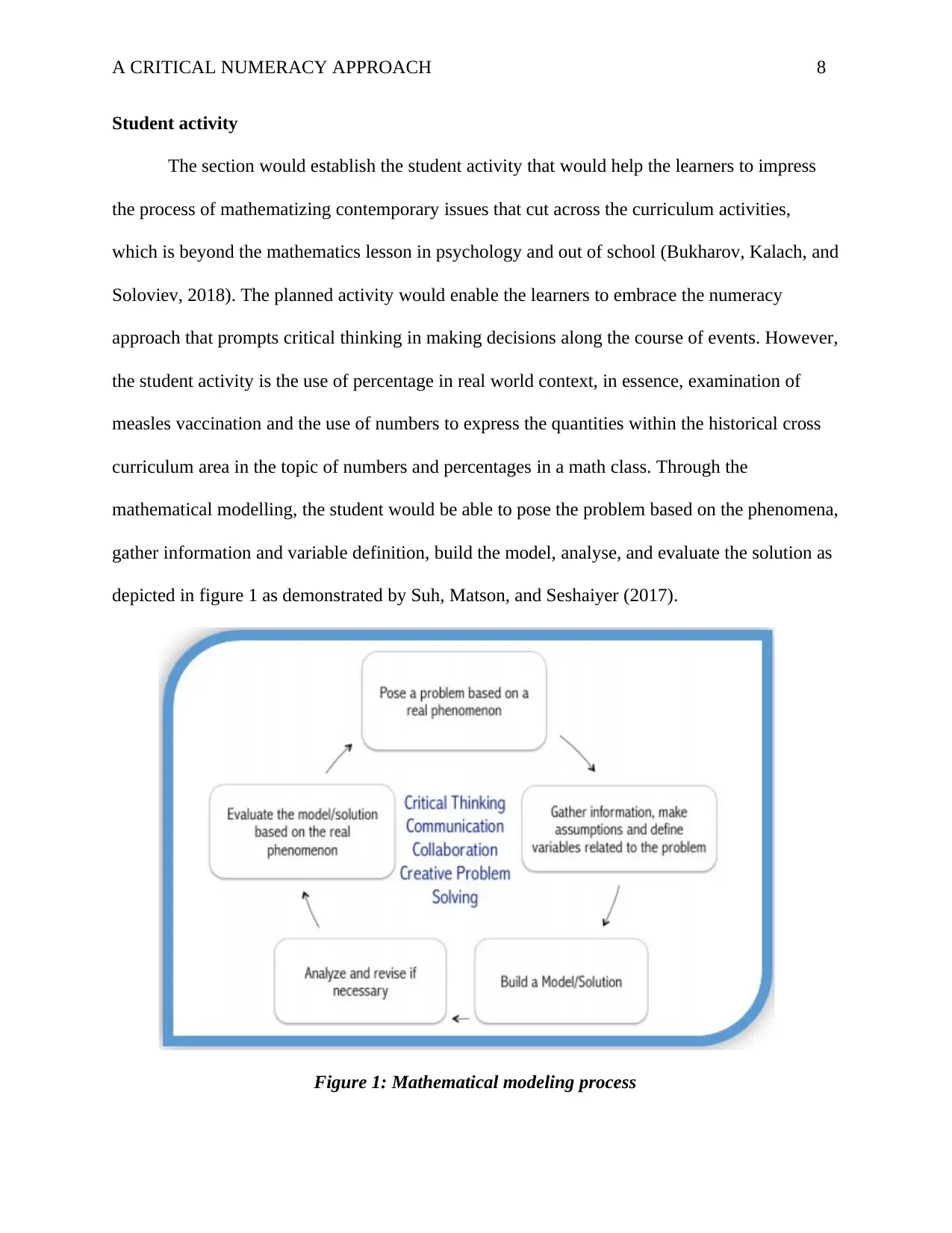
A CRITICAL NUMERACY APPROACH 8
Student activity
The section would establish the student activity that would help the learners to impress
the process of mathematizing contemporary issues that cut across the curriculum activities,
which is beyond the mathematics lesson in psychology and out of school (Bukharov, Kalach, and
Soloviev, 2018). The planned activity would enable the learners to embrace the numeracy
approach that prompts critical thinking in making decisions along the course of events. However,
the student activity is the use of percentage in real world context, in essence, examination of
measles vaccination and the use of numbers to express the quantities within the historical cross
curriculum area in the topic of numbers and percentages in a math class. Through the
mathematical modelling, the student would be able to pose the problem based on the phenomena,
gather information and variable definition, build the model, analyse, and evaluate the solution as
depicted in figure 1 as demonstrated by Suh, Matson, and Seshaiyer (2017).
Figure 1: Mathematical modeling process
Student activity
The section would establish the student activity that would help the learners to impress
the process of mathematizing contemporary issues that cut across the curriculum activities,
which is beyond the mathematics lesson in psychology and out of school (Bukharov, Kalach, and
Soloviev, 2018). The planned activity would enable the learners to embrace the numeracy
approach that prompts critical thinking in making decisions along the course of events. However,
the student activity is the use of percentage in real world context, in essence, examination of
measles vaccination and the use of numbers to express the quantities within the historical cross
curriculum area in the topic of numbers and percentages in a math class. Through the
mathematical modelling, the student would be able to pose the problem based on the phenomena,
gather information and variable definition, build the model, analyse, and evaluate the solution as
depicted in figure 1 as demonstrated by Suh, Matson, and Seshaiyer (2017).
Figure 1: Mathematical modeling process
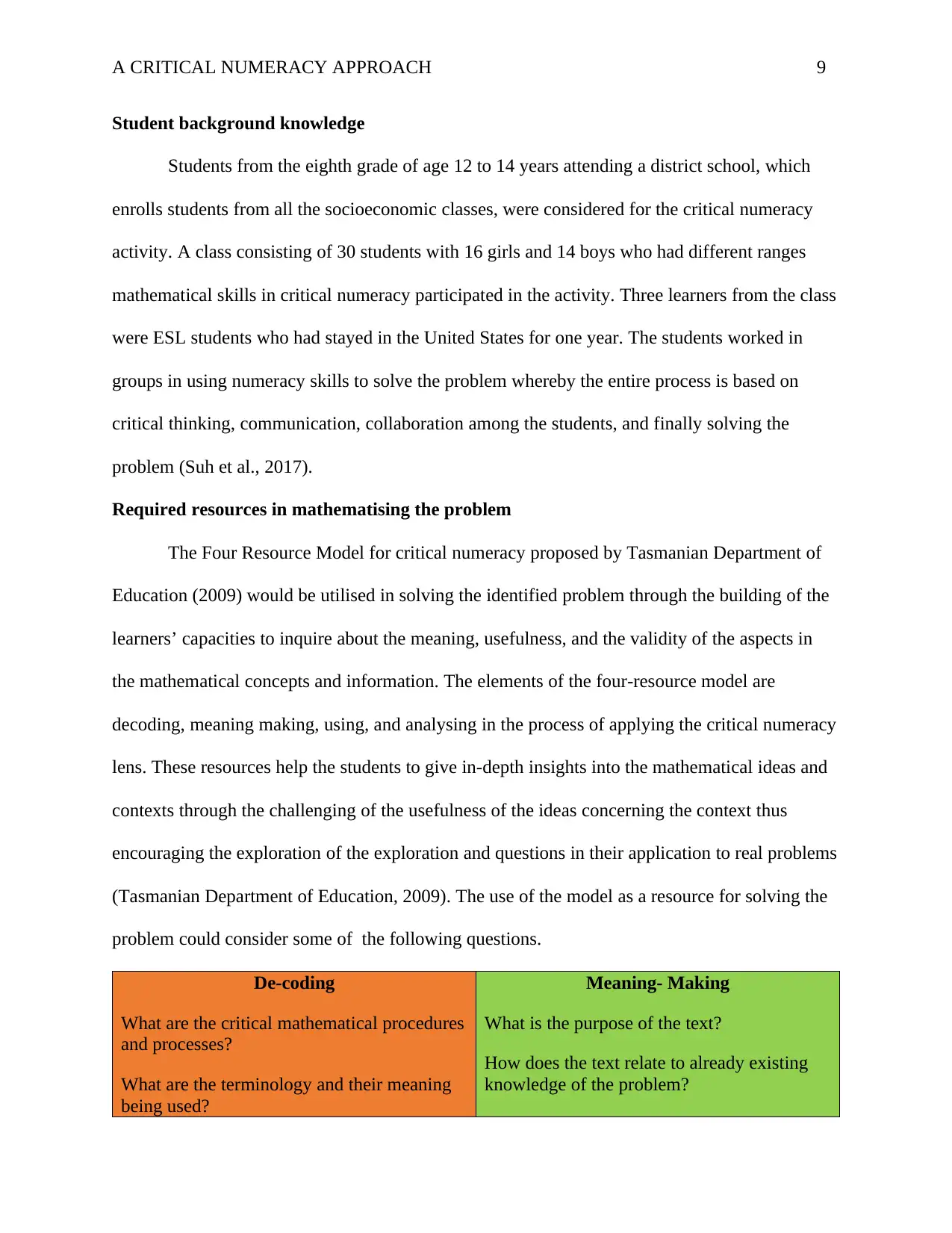
A CRITICAL NUMERACY APPROACH 9
Student background knowledge
Students from the eighth grade of age 12 to 14 years attending a district school, which
enrolls students from all the socioeconomic classes, were considered for the critical numeracy
activity. A class consisting of 30 students with 16 girls and 14 boys who had different ranges
mathematical skills in critical numeracy participated in the activity. Three learners from the class
were ESL students who had stayed in the United States for one year. The students worked in
groups in using numeracy skills to solve the problem whereby the entire process is based on
critical thinking, communication, collaboration among the students, and finally solving the
problem (Suh et al., 2017).
Required resources in mathematising the problem
The Four Resource Model for critical numeracy proposed by Tasmanian Department of
Education (2009) would be utilised in solving the identified problem through the building of the
learners’ capacities to inquire about the meaning, usefulness, and the validity of the aspects in
the mathematical concepts and information. The elements of the four-resource model are
decoding, meaning making, using, and analysing in the process of applying the critical numeracy
lens. These resources help the students to give in-depth insights into the mathematical ideas and
contexts through the challenging of the usefulness of the ideas concerning the context thus
encouraging the exploration of the exploration and questions in their application to real problems
(Tasmanian Department of Education, 2009). The use of the model as a resource for solving the
problem could consider some of the following questions.
De-coding
What are the critical mathematical procedures
and processes?
What are the terminology and their meaning
being used?
Meaning- Making
What is the purpose of the text?
How does the text relate to already existing
knowledge of the problem?
Student background knowledge
Students from the eighth grade of age 12 to 14 years attending a district school, which
enrolls students from all the socioeconomic classes, were considered for the critical numeracy
activity. A class consisting of 30 students with 16 girls and 14 boys who had different ranges
mathematical skills in critical numeracy participated in the activity. Three learners from the class
were ESL students who had stayed in the United States for one year. The students worked in
groups in using numeracy skills to solve the problem whereby the entire process is based on
critical thinking, communication, collaboration among the students, and finally solving the
problem (Suh et al., 2017).
Required resources in mathematising the problem
The Four Resource Model for critical numeracy proposed by Tasmanian Department of
Education (2009) would be utilised in solving the identified problem through the building of the
learners’ capacities to inquire about the meaning, usefulness, and the validity of the aspects in
the mathematical concepts and information. The elements of the four-resource model are
decoding, meaning making, using, and analysing in the process of applying the critical numeracy
lens. These resources help the students to give in-depth insights into the mathematical ideas and
contexts through the challenging of the usefulness of the ideas concerning the context thus
encouraging the exploration of the exploration and questions in their application to real problems
(Tasmanian Department of Education, 2009). The use of the model as a resource for solving the
problem could consider some of the following questions.
De-coding
What are the critical mathematical procedures
and processes?
What are the terminology and their meaning
being used?
Meaning- Making
What is the purpose of the text?
How does the text relate to already existing
knowledge of the problem?
⊘ This is a preview!⊘
Do you want full access?
Subscribe today to unlock all pages.

Trusted by 1+ million students worldwide
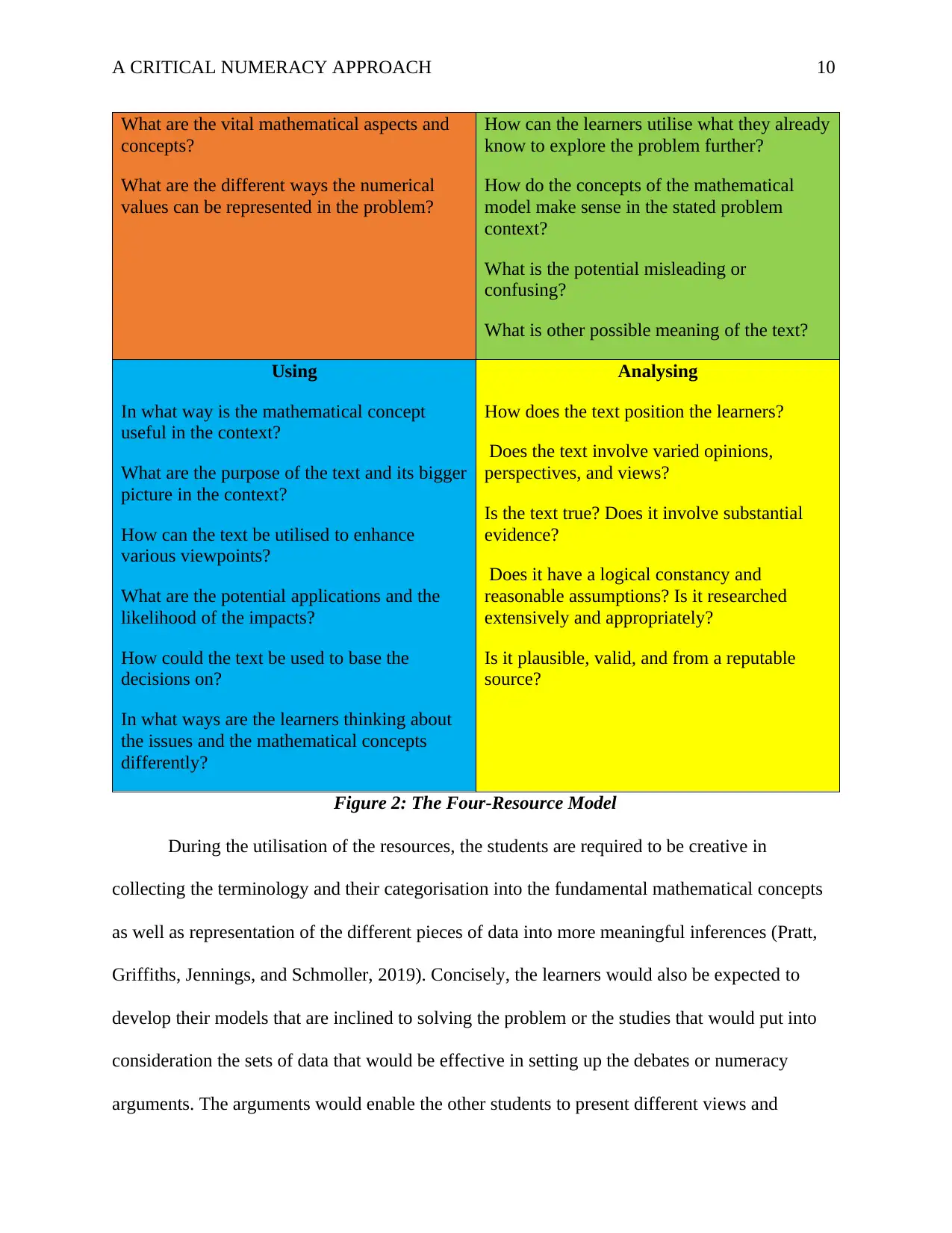
A CRITICAL NUMERACY APPROACH 10
What are the vital mathematical aspects and
concepts?
What are the different ways the numerical
values can be represented in the problem?
How can the learners utilise what they already
know to explore the problem further?
How do the concepts of the mathematical
model make sense in the stated problem
context?
What is the potential misleading or
confusing?
What is other possible meaning of the text?
Using
In what way is the mathematical concept
useful in the context?
What are the purpose of the text and its bigger
picture in the context?
How can the text be utilised to enhance
various viewpoints?
What are the potential applications and the
likelihood of the impacts?
How could the text be used to base the
decisions on?
In what ways are the learners thinking about
the issues and the mathematical concepts
differently?
Analysing
How does the text position the learners?
Does the text involve varied opinions,
perspectives, and views?
Is the text true? Does it involve substantial
evidence?
Does it have a logical constancy and
reasonable assumptions? Is it researched
extensively and appropriately?
Is it plausible, valid, and from a reputable
source?
Figure 2: The Four-Resource Model
During the utilisation of the resources, the students are required to be creative in
collecting the terminology and their categorisation into the fundamental mathematical concepts
as well as representation of the different pieces of data into more meaningful inferences (Pratt,
Griffiths, Jennings, and Schmoller, 2019). Concisely, the learners would also be expected to
develop their models that are inclined to solving the problem or the studies that would put into
consideration the sets of data that would be effective in setting up the debates or numeracy
arguments. The arguments would enable the other students to present different views and
What are the vital mathematical aspects and
concepts?
What are the different ways the numerical
values can be represented in the problem?
How can the learners utilise what they already
know to explore the problem further?
How do the concepts of the mathematical
model make sense in the stated problem
context?
What is the potential misleading or
confusing?
What is other possible meaning of the text?
Using
In what way is the mathematical concept
useful in the context?
What are the purpose of the text and its bigger
picture in the context?
How can the text be utilised to enhance
various viewpoints?
What are the potential applications and the
likelihood of the impacts?
How could the text be used to base the
decisions on?
In what ways are the learners thinking about
the issues and the mathematical concepts
differently?
Analysing
How does the text position the learners?
Does the text involve varied opinions,
perspectives, and views?
Is the text true? Does it involve substantial
evidence?
Does it have a logical constancy and
reasonable assumptions? Is it researched
extensively and appropriately?
Is it plausible, valid, and from a reputable
source?
Figure 2: The Four-Resource Model
During the utilisation of the resources, the students are required to be creative in
collecting the terminology and their categorisation into the fundamental mathematical concepts
as well as representation of the different pieces of data into more meaningful inferences (Pratt,
Griffiths, Jennings, and Schmoller, 2019). Concisely, the learners would also be expected to
develop their models that are inclined to solving the problem or the studies that would put into
consideration the sets of data that would be effective in setting up the debates or numeracy
arguments. The arguments would enable the other students to present different views and
Paraphrase This Document
Need a fresh take? Get an instant paraphrase of this document with our AI Paraphraser
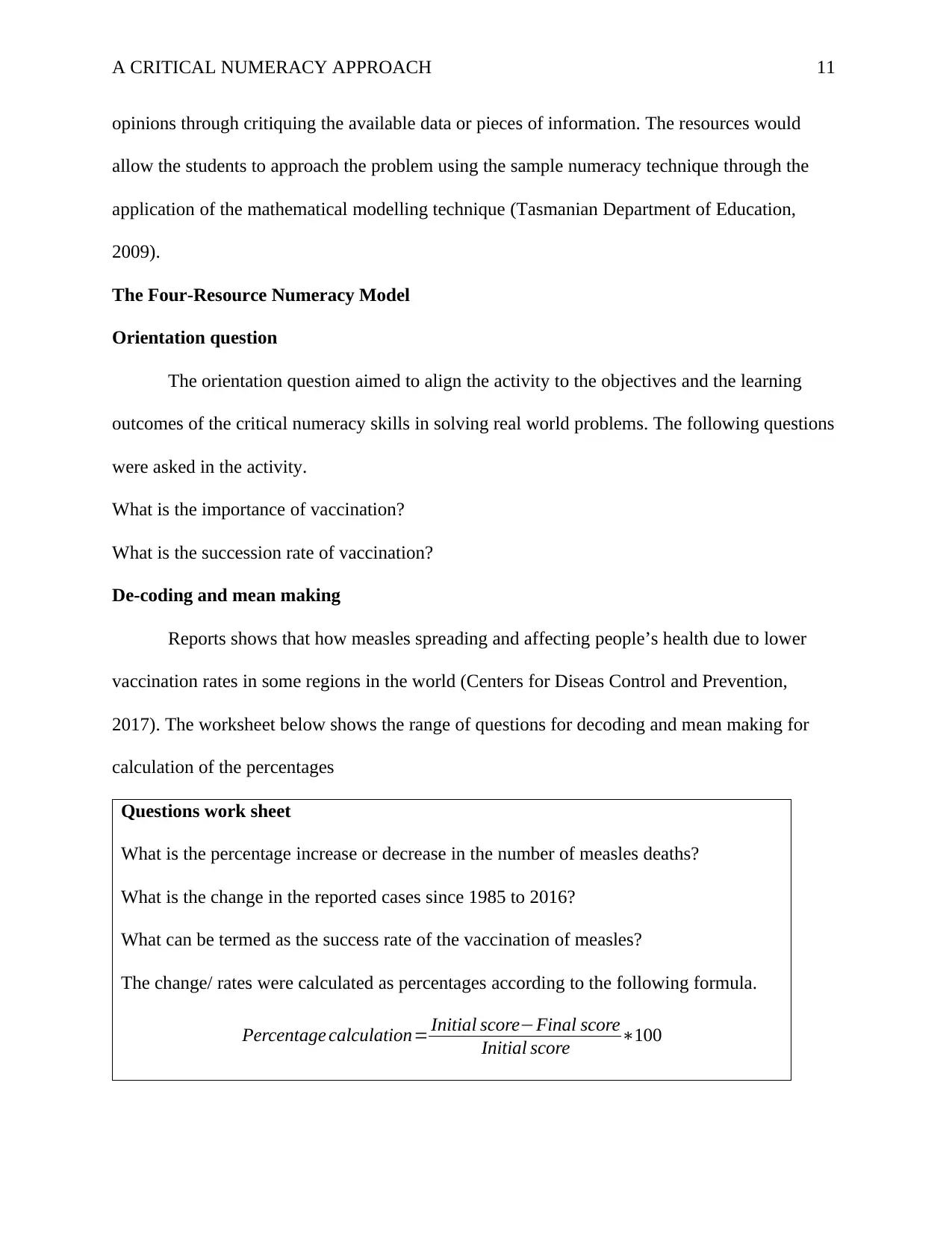
A CRITICAL NUMERACY APPROACH 11
opinions through critiquing the available data or pieces of information. The resources would
allow the students to approach the problem using the sample numeracy technique through the
application of the mathematical modelling technique (Tasmanian Department of Education,
2009).
The Four-Resource Numeracy Model
Orientation question
The orientation question aimed to align the activity to the objectives and the learning
outcomes of the critical numeracy skills in solving real world problems. The following questions
were asked in the activity.
What is the importance of vaccination?
What is the succession rate of vaccination?
De-coding and mean making
Reports shows that how measles spreading and affecting people’s health due to lower
vaccination rates in some regions in the world (Centers for Diseas Control and Prevention,
2017). The worksheet below shows the range of questions for decoding and mean making for
calculation of the percentages
Questions work sheet
What is the percentage increase or decrease in the number of measles deaths?
What is the change in the reported cases since 1985 to 2016?
What can be termed as the success rate of the vaccination of measles?
The change/ rates were calculated as percentages according to the following formula.
Percentage calculation= Initial score−Final score
Initial score ∗100
opinions through critiquing the available data or pieces of information. The resources would
allow the students to approach the problem using the sample numeracy technique through the
application of the mathematical modelling technique (Tasmanian Department of Education,
2009).
The Four-Resource Numeracy Model
Orientation question
The orientation question aimed to align the activity to the objectives and the learning
outcomes of the critical numeracy skills in solving real world problems. The following questions
were asked in the activity.
What is the importance of vaccination?
What is the succession rate of vaccination?
De-coding and mean making
Reports shows that how measles spreading and affecting people’s health due to lower
vaccination rates in some regions in the world (Centers for Diseas Control and Prevention,
2017). The worksheet below shows the range of questions for decoding and mean making for
calculation of the percentages
Questions work sheet
What is the percentage increase or decrease in the number of measles deaths?
What is the change in the reported cases since 1985 to 2016?
What can be termed as the success rate of the vaccination of measles?
The change/ rates were calculated as percentages according to the following formula.
Percentage calculation= Initial score−Final score
Initial score ∗100

A CRITICAL NUMERACY APPROACH 12
Analysis
The analysis of the collected data can be done in groups. The process falls under the
analysis section of the four-resource model after decoding, meaning making, and using stages.
The analysis process takes centre stage in determining the position of the learners’ views,
evaluation of the approaches used in arriving at judgments, the validity, and the plausibility of
the information. Additionally, consistency in the text is essential as well as evaluation of the
logical textures used in synthesising the sources and the credibility of the data (Card, 2019).
From the provided graph, the success rate of the measles vaccination was determined using the
series of questions from the questions in the worksheet above. The graph indicates that the
number of lives saved from vaccination against measles increased drastically, due to the decrease
in deaths because of measles disease.
Analysis
The analysis of the collected data can be done in groups. The process falls under the
analysis section of the four-resource model after decoding, meaning making, and using stages.
The analysis process takes centre stage in determining the position of the learners’ views,
evaluation of the approaches used in arriving at judgments, the validity, and the plausibility of
the information. Additionally, consistency in the text is essential as well as evaluation of the
logical textures used in synthesising the sources and the credibility of the data (Card, 2019).
From the provided graph, the success rate of the measles vaccination was determined using the
series of questions from the questions in the worksheet above. The graph indicates that the
number of lives saved from vaccination against measles increased drastically, due to the decrease
in deaths because of measles disease.
⊘ This is a preview!⊘
Do you want full access?
Subscribe today to unlock all pages.

Trusted by 1+ million students worldwide
1 out of 20
Related Documents
Your All-in-One AI-Powered Toolkit for Academic Success.
+13062052269
info@desklib.com
Available 24*7 on WhatsApp / Email
![[object Object]](/_next/static/media/star-bottom.7253800d.svg)
Unlock your academic potential
Copyright © 2020–2025 A2Z Services. All Rights Reserved. Developed and managed by ZUCOL.





